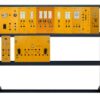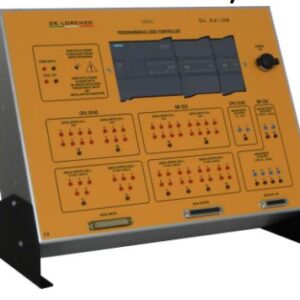TECHNICAL SPECIFICATIONS
The trainer is composed of operating unit composed of:
MAIN UNIT AND CONTROL PANEL
It contains the components for the circulation, storage and control of the liquid in the primary and secondary circuits. These components are placed vertically on a base, facilitating comfortable access
to all parts for a display of the actual components used in systems. The front control panel is placed in the top part of the main module and it is composed of: block diagram of the system, electronic control centre with an LCD screen for the visualization of the data, situation lights. Through the control panel it is possible to determine the set points and visualize the temperature changes, flow, etc.
HOT WATER CIRCUIT AND SOLAR THERMALSTATION
In the lower part there is mounted a 65-liter tank for the accumulation of domestic hot water. The heat exchange between the collector (primary circuit) and the buffer tank (secondary circuit) is obtained by a plate heat exchanger. The relevant circulation pumps, controlled by the main unit,manage the two circuits.
SOLAR THERMAL COLLECTOR
The solar collector is mounted on the rear side of the panel and it is adjustable.
The system comes complete with all necessary components, such as thermometers, pressurerelief valves, expansion tank, flow meters, etc.
SOLAR THERMAL ENERGY TRAINER
Didactic system for the theoretical and practical study of solar power facilities used to obtain hot water for sanitation and similar services.
It is a forced circulation system with a wide range of didactic applications. It incorporates six temperature probes available at different points, and a solar irradiation sensor that is used to calculate energy.
TRAINING OBJECTIVES
o Identification and familiarization of the components
o Interpretation of the technical parameters of all components.
o Functioning of the collector and the heating circuits and how they operate.
o Observation and analysis of the collector efficiency
o Local control of the processor
o Definition of the net power
o Study of the relationship between flow and net power
o Determining the correlation between the temperature variation (collector/environment) and the collector efficiency
o Heating and checking of the convector heater
o Assembly and maintenance criteria for facilities.
o Interpretation of situational data supplied by
the control
















